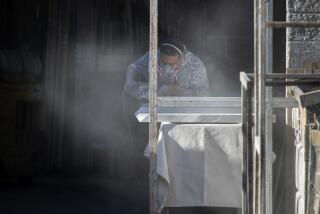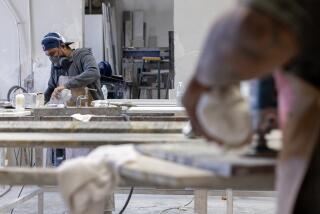Bill Targets Nail Salon Outbreaks
- Share via
Concerned that intense competition among nail salons has prompted some businesses to cut corners on health standards, state officials may require salons to post citations on their windows similar to restaurant letter grades.
The rules, contained in a bill that has passed the Assembly and goes before the state Senate Appropriations Committee in the next week, come after three mycobacterial outbreaks at salons in Northern California infected more than 200 people over the last few years.
Its author, Assemblyman Leland Yee (D-San Francisco), said the legislation was aimed at cracking down on salons that don’t follow state safety standards for manicure equipment. The bill would require more stringent rules for disinfecting those items and disposing of water from spas where customers soak their hands and feet.
Yee said posting health inspectors’ reports in windows would educate the public and serve to keep the salons in line.
But some shop owners are skeptical about posting health records on their windows.
At Dynasty Salon in South Pasadena, Rose Hang, a Chinese-Vietnamese immigrant, works 10 hours a day, six days a week. She strives to keep her salon clean; even her bathroom has a sign that reads “keep it clean.” Despite Hang’s efforts, her salon has received several citations from the state involving cleanliness issues since 1998.
Nail salons are a nearly $7-billion industry nationwide, according to Nails magazine, a Torrance-based trade publication.
Most nail salons are small operations, with a national average of 2.6 technicians in each shop, and each person earning an average $541 a week, according to a 2004 Nails survey.
Manicuring is regulated by the state Board of Barbering and Cosmetology, which defines the practice as cutting, trimming, polishing, coloring, tinting or cleansing the nails, or massaging, cleansing, treating or beautifying the hands or feet.
There has been an effort by nail salons recently to consolidate more massage services with their businesses, adding to the popularity of salons with pedicure foot spas.
But bacteria can grow to “unusually high levels” in these footbaths from hair and skin debris that builds up inside the tubs if they are not disinfected properly, according to the state board. Officials said the bacteria can give customers infections or lesions -- especially if customers have a cut from shaving or another type of small, open wound.
In recent years, the industry has undergone increasing scrutiny, prompted by three bacterial outbreaks in Northern California. A Watsonville salon in 1999 and 2000 infected more than 100 women, according to Yee’s office. In 2004, about 27 San Jose salons infected more than 120 people altogether with bacteria, his office said.
One infected customer was 19-year-old Brittany Welby of San Jose, who got her toes done last fall for $18 at a neighborhood salon. The infection lasted six months and left red, open sores the size of pennies on her legs, she said.
“I just hope [the bill] gets passed so it doesn’t happen to anyone else,” Welby said. “If there’s an unsanitized salon, like the one I went to, I wish I would have known beforehand,” she said.
In June, “American Idol” judge Paula Abdul testified before a state Senate committee, recounting her struggle with a staph infection under a thumbnail that she said was caused by a Studio City shop using unsanitary instruments.
If the legislation becomes law, nail salon owners will be required to post a notice in their windows indicating whether the business was fined or cited, or if its license was suspended. How long the notices would remain or how detailed they’d be would be up to the barbering and cosmetology board.
The bill also would push the state board to set minimum safety specifications for pedicure equipment and to give the board leeway to establish other requirements for the manufacture or modification of whirlpool pedicure equipment. Current standards require pedicure spas to be cleaned and inspected daily but don’t regulate the type of foot spas used.
The bill “sets up a system in which consumers will be protected,” said Adam Keigwin, Yee’s spokesman. “They’ll know what type of salon this is.”
The bill passed the Assembly on June 1 in a 74-3 vote. Assemblywoman Mimi Walters (R-Laguna Niguel) objected to the bill because she thought the rules should be created by the state board, not the Legislature, said Gina Zari, Walters’ chief of staff.
The new rules probably would require more state inspectors. There are 9,555 licensed establishments in Los Angeles County, and 33,911 in the state. Now, nine people among California’s 18 inspectors monitor nail salons from Santa Barbara to the Mexican border, said the board’s spokesman, Kevin Flanagan.
If the bill passes, it will increase the number of inspectors by four to six people. The inspectors generally check salons that have received past complaints and determine whether they follow the board’s safety standards, Flanagan said.
“I don’t know how you would enforce the new rules,” said 41-year-old Sheri Griffin of Newport Beach, who got a pedicure infection in June 2004. “They don’t have the capacity or number of people to check on them.”
The infection caused half-inch to 1-inch purple boils filled with pus on Griffin’s right leg, she said. Griffin, who has two purple scars from the ordeal, said she spent $1,500 on doctor visits, antibiotics and medical tests. She sometimes wears makeup to cover the scars.
Mike Vassin, manager of Salon Basix in Costa Mesa, said he supported the legislation but doubted that it would have much of an effect.
Vassin said some of his clients have caught infections at other nail spas but continue to go to them because their lower prices are too enticing.
“They’ll pay $68 for a haircut,” he said of his salon. “But they’ll still want that $10 manicure.”
“Prices keep going lower and lower,” he said. “The lower it goes, the lower the standard.”
Times staff writer Nicholas Shields contributed to this report.
More to Read
Get the L.A. Times Politics newsletter
Deeply reported insights into legislation, politics and policy from Sacramento, Washington and beyond. In your inbox three times per week.
You may occasionally receive promotional content from the Los Angeles Times.











